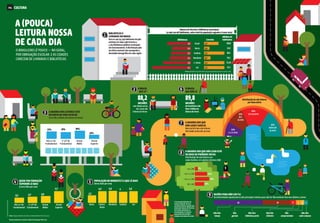Denunciar
Compartilhar
Baixar para ler offline

Recomendados
Trabalho apresentado no dia 09/12/2010, durante o II Seminário de Iniciação Científica da FESPSP.Leitores de rua - Ana Eliza Grigorio Rodrigues, Damaris Siqueira Brito, Fab...

Leitores de rua - Ana Eliza Grigorio Rodrigues, Damaris Siqueira Brito, Fab...Monitor Científico FaBCI
Recomendados
Trabalho apresentado no dia 09/12/2010, durante o II Seminário de Iniciação Científica da FESPSP.Leitores de rua - Ana Eliza Grigorio Rodrigues, Damaris Siqueira Brito, Fab...

Leitores de rua - Ana Eliza Grigorio Rodrigues, Damaris Siqueira Brito, Fab...Monitor Científico FaBCI
Mais conteúdo relacionado
Destaque
Destaque (20)
Product Design Trends in 2024 | Teenage Engineerings

Product Design Trends in 2024 | Teenage Engineerings
How Race, Age and Gender Shape Attitudes Towards Mental Health

How Race, Age and Gender Shape Attitudes Towards Mental Health
AI Trends in Creative Operations 2024 by Artwork Flow.pdf

AI Trends in Creative Operations 2024 by Artwork Flow.pdf
Content Methodology: A Best Practices Report (Webinar)

Content Methodology: A Best Practices Report (Webinar)
How to Prepare For a Successful Job Search for 2024

How to Prepare For a Successful Job Search for 2024
Social Media Marketing Trends 2024 // The Global Indie Insights

Social Media Marketing Trends 2024 // The Global Indie Insights
Trends In Paid Search: Navigating The Digital Landscape In 2024

Trends In Paid Search: Navigating The Digital Landscape In 2024
5 Public speaking tips from TED - Visualized summary

5 Public speaking tips from TED - Visualized summary
Google's Just Not That Into You: Understanding Core Updates & Search Intent

Google's Just Not That Into You: Understanding Core Updates & Search Intent
The six step guide to practical project management

The six step guide to practical project management
Beginners Guide to TikTok for Search - Rachel Pearson - We are Tilt __ Bright...

Beginners Guide to TikTok for Search - Rachel Pearson - We are Tilt __ Bright...
Censo brasil-cultura
- 1. 224 CULTURA | referências 225referências | CULTURA ALMANAQUE ABRIL 2012ALMANAQUE ABRIL 2012 referências | cultura 225referências | CULTURA CULTURA|referências CULTURA|referências Fontes: Ministério da Cultura/FGV 2009, Associação Nacional das Livrarias, 2009 Fonte: Pesquisa Retratos da Leitura no Brasil/Instituto Pró-Livro, 2011 Versão atualizada em relacão à edição do Almanaque Abril 2012 A (POUCA) LEITURA NOSSA DE CADA DIA O BRASILEIRO LÊ POUCO — NO GERAL, POR OBRIGAÇÃO ESCOLAR. E AS CIDADES CARECEM DE LIVRARIAS E BIBLIOTECAS BIBLIOTECAS E LIVRARIAS NO BRASIL Para os 190.755.799 habitantes do país existiam em 2009 2.980 livrarias e 4.763 bibliotecas públicas municipais em funcionamento. A distribuição pelo território nacional não acompanha a densidade demográfica de cada região O BRASIL QUE LÊ * 88,2 MILHÕES com idade acima de 5 anos são leitores de livros O BRASIL QUE NÃO LÊ 89,8 MILHÕES de brasileiros não têm o hábito da leitura de livrosA MAIORIA DOS LEITORES ESTÁ NO INÍCIO DA VIDA ESCOLAR (% de 88,2 milhões de leitores de livros) LivrariasBibliotecas 4,1 2,1Sul C.-Oeste Nordeste Sudeste Norte Brasil 2,1 0,7 2,1 0,6 1,5 2,9 2,2 2,1 2,0 2,5 (*) A pesquisa Retratos da Leitura no Brasil, de 2011, considera leitores aqueles que leram pelo menos um livro nos três meses anteriores ao levantamento. O universo pesquisado desconsidera crianças com menos de 5 anos. QUEM TEM FORMAÇÃO SUPERIOR LÊ MAIS (Livros lidos por ano) Até a 4ª do Fundamental 5ª a 8ª do Fundamental Ensino Médio Ensino Superior 2,5 3,7 3,9 7,7 POPULAÇÃO DO NORDESTE É A QUE LÊ MAIS (livros lidos por ano) Milhões de habitantes 27,4 14,10 53,1 80,3 15,9 190,8 A MAIORIA DOS QUE NÃO LEEM É ADULTA Mais de 60% dos não leitores têm idade acima dos 30 anos 14% 5 a 17 anos 22% 18 a 29 anos 34% 30 a 49 anos 31% Acima de 50 anos Até a 4ª do Fundamental 5ª a 8ª do Fundamental Ensino Médio Ensino Superior 16% 30%26%27% A MAIORIA DOS QUE NÃO LEEM ESTÁ NA BASE DA PIRÂMIDE SOCIAL Distribuição de não leitores por renda familiar, em salários mínimos (SM) 7% 32% 39% 22%Até 1 SM + de 1 a 2 SM + de 2 a 5 SM + de 5 SM RAZÕES PARA NÃO LER (%) Os entrevistados apontaram os dois principais motivos para não ter lido nenhum livro nos últimos 3 meses Não têm tempo Não compreendem Não gostam Não têm dinheiro Não têm biblioteca perto Não têm onde comprar Número de livrarias e bibliotecas municipais (a cada 100 mil habitantes, sobre total da população segundo o Censo 2010) Distribuição de não leitores por faixa etária 53 30 6 5 4 4 2,7 4,2 4,3 4 4,2 Norte Centro- Oeste Nordeste Sudeste Sul 1 2 6 7 8 9 3 54 224 culturamulti/speBrunoNogueira
